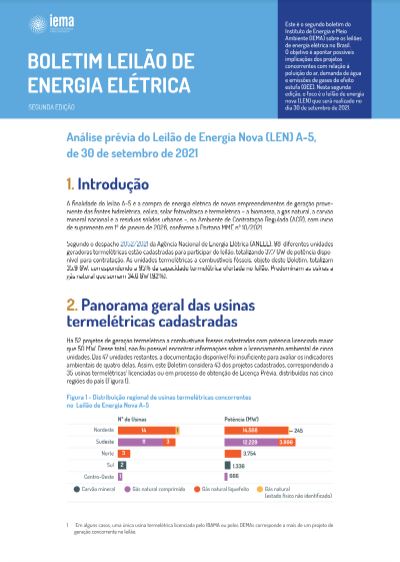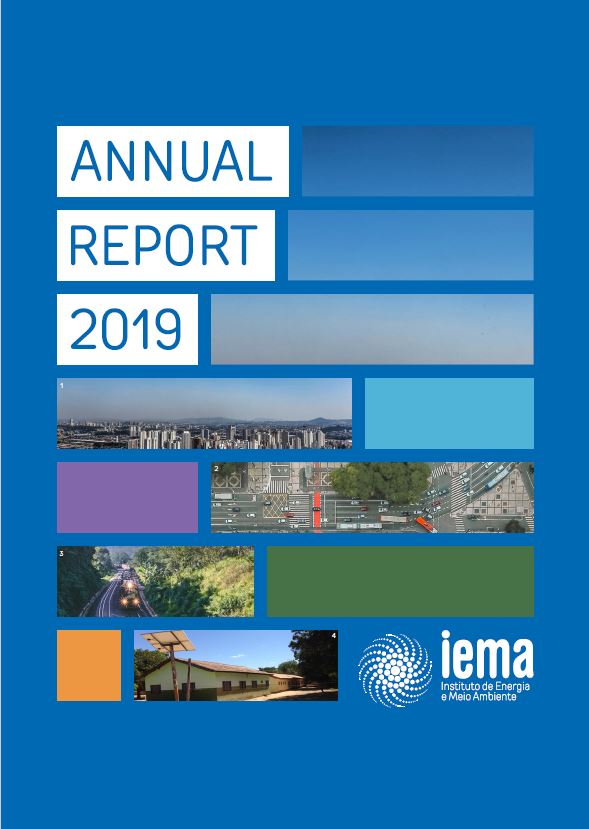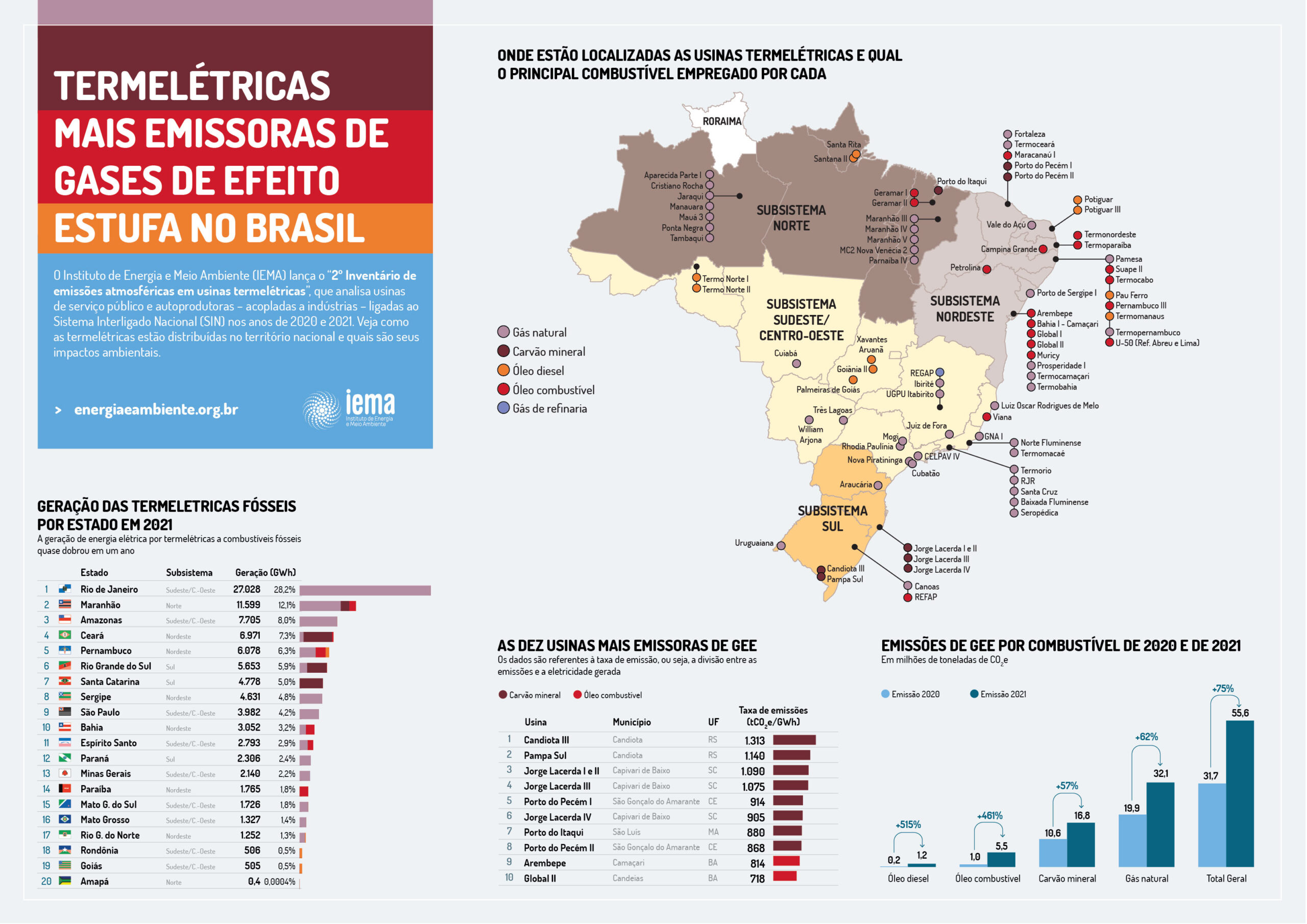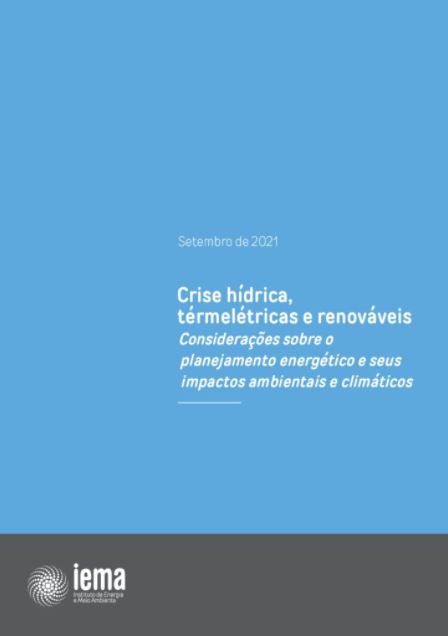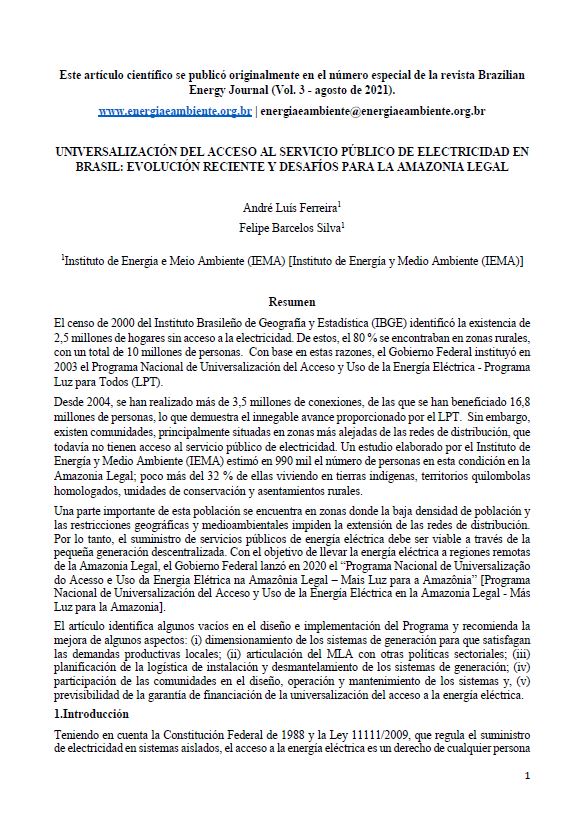Generation of electricity, emissions and list of companies that own fossil fuel thermal power plants in the National Interconnected System (base year 2021)
December 2022
PRESENTATION
Since the early 2000s, the Brazilian electrical matrix has been going through a transition in which the expansion of installed capacity and hydroelectric generation gives way to a growing diversification of generation sources. If, on the one hand, there is a marked increase in biomass, wind and solar sources, on the other hand, there is an expansion of fossil fuels usage to generate electricity. This generation increased from 30.6 TWh in 2000 to 133.8 TWh in 2021, a fourfold increase.
Bearing in mind the environmental, social and economic implications of this transition, the Institute of Energy and the Environment (IEMA) has been dedicating itself to a set of studies and analyses with the goal of drawing the attention of the government, non-governmental organizations, the media, researchers and society in general to the environmental impacts of thermal power plants. The results of the work have been disseminated through a series of publications aimed at providing subsidies to the evaluation process, environmental licensing and qualification of enterprises. In addition, we seek to contribute to the sharing of information and decision-making on the feasibility of these projects.
Thermoelectric generation and its correlation with pollutant emissions were addressed in two of the first publications: “Environmental regulation of thermoelectricity in Brazil – control of pollutant emissions” and “Thermoelectric generation and atmospheric emissions: pollutants and control systems”. More recently, it has been also exposed in the “Electric Energy Auction Bulletin” (continuously published) and in the technical note “Air Quality in Macaé (RJ)” .
With these studies, a database was consolidated with technical and environmental parameters of the plants, such as: fuel used, thermodynamic cycle, types of control systems adopted, potential atmospheric emissions and use of water for cooling. Therefore, a data consolidation methodology was improved, including criteria for cases of missing or inconsistent information.
This publication systematizes these data into emission rankingsof fossil thermal power plants that supplied energy to the National Interconnected System in 2021, as well as their respective owners.
It is important to point out that it was decided to use the Reports of Potentially Polluting Activities and Users of Environmental Resources from the Brazilian Institute of the Environment and Renewable Natural Resources (Ibama) as sources of information, as they proved to be more complete in terms of availability of data from fuel consumption and emissions of local air pollutants.
The publication is also opportune when looking at the medium and long term, with the forecast, according to Law 14,182/2021, for the installation of 8,000 MW in gas-fired power plants spread across the North, Northeast, Midwest and Southeast regions of Brazil – which will enter the system between 2026 and 2030 – and with the postponement of subsidies and the useful life of coal-fired power plants until 2040, according to Law 14,299/2022.
The current context of the electricity sector presents high risks for its decarbonization plans towards a 100% renewable matrix, as well as for improving air quality in the country. Thus, with this second edition of the inventory, aimed at executives from the electricity sector, environmental defenders, financial analysts, investors, journalists, regulators and policy makers, IEMA places itself in the roles of provider of qualified information and critical observer of environmental impacts in recent years and forecast for the next two decades.
EXECUTIVE SUMMARY
ELECTRIC POWER GENERATION
Scope of this inventory
Brazilian electrical matrix in transition
● Since the beginning of the 2000s, the Brazilian electricity matrix has been going through a transition characterized by the increasing participation of non-hydro renewables, such as biomass and wind, and by the expansion of the use of fossil fuels. From 2000 to 2021, the total power generation grew by 88%, while generation by hydraulic sources showed a much lower increase (19%).
● The hydraulic source slightly reduced its dominance in the Brazilian electrical matrix from 2020 to 2021. Due to the severe water crisis faced in that period and its consequences, hydroelectric generation in 2021 was 8% lower than in the previous year, reaching a total of 362.8 TWh against 396.4 TWh produced in 2020. In this scenario, the participation of fossil thermoelectricity in the national matrix jumped from 15% in 2020 to 20% in 2021, the year in which it reached around 134 TWh of electricity produced.
● Although the high fossil participation in the electrical matrix in 2021 can be considered a one-off event as it reflects a theoretically atypical moment in hydroelectric generation, there has been a consistent increase in the use of fossil thermoelectricity over the years, especially since the 2010s. Fossil generation increased from 30.6 TWh in 2000 to 92 TWh in 2020 (which represents an increase of 200%), resulting in a 113% increase in greenhouse gas emissions from the power generation sector (SEEG, 2022).
● Thermoelectric generation from the set of plants contained in this study was 95.8 TWh in 2021. A group of 82 power plants were responsible for this amount. Altogether, 68.9 TWh were produced from natural gas (44 power plants), which corresponds to 72% of the total.
● Second in share, mineral coal (eight plants) was responsible for generating 16.5 TWh, which represents 17% of fossil electricity production. Fuel oil (18 plants) and diesel oil (11 plants), petroleum derivatives, accounted for 9% and 2%, respectively. A single plant generated electricity using refinery gas as the main fuel, with a very low share in relation to the total inventoried.
● The inventoried generation (fossil electricity injected into the National Interconnected System) grew significantly from 2020 to 2021 (77%). The absolute variation observed was 41.6 TWh, equivalent to everything generated from natural gas in 2020.Of these 41.6 TWh, 66% was produced by natural gas plants, 17% by fuel oil thermal plants, 13% by mineral coal plants and 4% by diesel oil powered plants.
● Only 3% of all electricity generation in 2021 came from plants that did not operate in 2020. This indicates that the plants that were already running in 2020 started to increase their operation even more, being largely responsible for the increase in generation.
Rankingof generation by thermal power plant
● Only five plants accounted for more than a quarter of the inventoried thermoelectric generation: Norte Fluminense, with 6.5 TWh (6.8%); Termorio, with 5.7 TWh (5.9%); Termomacaé, with 5.3 TWh (5.5%); Porto de Sergipe I, with 4.6 TWh (4.8%); and Mauá 3, with 4.1 TWh (4.2%). In addition, 44% of the inventoried generation came from just ten plants and almost all of the electricity produced in 2020 (90%) was made available to the National Interconnected System (SIN) by only half of the total set of plants.
● Compared to 2020, 15 of the 82 inventoried plants increased their power generation by more than 1,000 GWh. Termomacaé and Porto do Sergipe I (the country’s highest generation thermal power plant) stood out – with an absolute increase in generation greater than 3.5 TWh each. Among the coal-fired plants, Porto do Pecém I had the most significant increase in power generation, which more than doubled from 2020 to 2021, having generated 2.0 TWh more in 2021. In addition, in 2021, the GNA 1 plant, second largest power plant in Brazil, started its operation, having produced 2.2 TWh.
Energy efficiency ranking of thermoelectric plants
● The energy efficiency of a thermal power plant indicates the portion of the energy released by the fuel that is converted into electricity. More efficient plants burn less fuel and emit less greenhouse gases per gigawatt-hour (GWh) produced.
● At the lower end of efficiency are four coal-powered thermal power plants. The natural gas plants occupied the first 12 places in the SIN fossil thermoelectric park efficiency ranking.
● Among the five plants with the lowest energy efficiency, four are powered by coal: Candiota III, with only 28% efficiency, in addition to Jorge Lacerda I and II, Pampa Sul and Jorge Lacerda III, all with an average efficiency of 32%.
Distribution of power generation in the territory
● Although the Northeast subsystem concentrates the largest number of thermal power plants (29 units), the Southeast/Center-West subsystem (27 plants) generated the most electricity from fossil sources in 2021 (40.0 TWh, 42% of the total inventoried).
● Power generation is concentrated in a few states: 62% of electricity from fossil fuel sources was produced in just five states. Rio de Janeiro, Maranhão and Amazonas accounted for more than 48% of the total fossil fuel electricity produced. Followed by the states of Ceará and Pernambuco.
● Rio de Janeiro alone produced 28% of all fossil fuel power generation in the SIN, having generated 27.0 TWh – double the amount produced by that state in 2020.
● Fossil fuel thermal power plants connected to the SIN are distributed in 49 municipalities, but 41% of the 2021 power generation was concentrated in just five: Macaé (RJ), Santo Antônio dos Lopes (MA), Manaus (AM), São Gonçalo do Amarante (CE) and Duque de Caxias (RJ).
GREENHOUSE GAS EMISSIONS
Rankingof emissions by thermoelectric plant
● The 82 inventoried plants emitted 55.6 million tons of carbon dioxide equivalent (CO2e) in 2021, which represents a 75% increase in comparison to the total emitted by the SIN’s fossil thermal power plants park in 2020.
● Only 13 plants emitted 51% of greenhouse gases (GHG), eight using mineral coal as the main fuel and another five running on natural gas. Almost all of the inventoried CO2e(90%) came from only 41 plants, which represents half of the SIN’s fossil power plants.
● Porto do Pecém I plant, powered by mineral coal, which is a high emitter of greenhouse gases,stands out since it doubled its generation in 2021 compared to the previous year and, consequently, emerged in the ranking as the one with the highest emission in the country.[HS|I1]
Emission rate per thermal power plant (tCO2 e/GWh)
● For a comparative assessment of the performance of thermal power plants in terms of emissions, a very suitable indicator is the emission rate, determined by the division between emissions and electricity generation of a plant. The figure below shows the ten power plants that had the highest emission rates in 2021. It can be seen that the eight plants with the highest emission rates are coal-powered.
Rankingof emissions by generating companies
● Fossil fuel thermoelectric generation and CO2eemissionswere allocated to power generating companies according to their respective shareholdings stakes in each plant inventoried. Despite having a relatively large number of generating companies (51), only six companies were responsible for almost 70% of all fossil generation inventoried for 2021: Petrobras (30.3%), Eneva (12.8%), Eletrobras (9.6%), Électricité de France – EDF (6.8%), Fram Capital Energy (5.0%) and EDP Energias do Brasil (4.0%).
● Four companies accounted for 61% of 2021 emissions: Petrobras (26.1%), Eneva (13.9%), Eletrobras (11.8%) and Fram Capital Energy (8.8%). Followed by other six companies: EDP (6.3%), Électricité de France – EDF (4.5%), Engie (3.2%), Global (2.6%), Vulcan (2.2%) and Neoenergia (2.2%). These ten companies alone were responsible for 82% of emissions, which is equivalent to 45.4 million tons of greenhouse gases emitted.
● Petrobras emitted of 6.2 million tons of greenhouse gases in 2021 compared to the previous year, an amount that is almost twice as much as the Porto do Pecém I plant from Ceará, which had the highest emission of 2021. Eneva and Eletrobras emitted a surplus of 3.1 and 2.2 million tons of GHG, respectively.
Emissions rate per generating company (tCO2 e/GWh)
● Regarding the rate of CO2e emissions, the company that produced the most greenhouse gases per GWh generated in 2021 was Engie, with 1,140 tCO2e/GWh – almost double the average observed in the SIN (582 tCO2e/GWh). This is due to the fact that Engie, despite having sold the large Jorge Lacerda Complex coal power plant to Fram Capital Energy, it has remained the full shareholder of Pampa Sul, a coal-powered thermal power plant with the second highest issue of this inventory.
● Even though Petrobras was the biggest emitter in absolute terms in 2021, it had an emission rate (468 tCO2 e/GWh) 20% lower than the average of fossil fuel thermal power plants in the SIN. This is because most of the plants controlled by it use technologies that achieve greater energy efficiency.
Distribution of greenhouse gas emissions in the territory
● The Southeast/Center-West subsystem, the largest emitter, was responsible for 34% of the total emissions in 2021, mainly due to the state of Rio de Janeiro. Then comes the Northeast subsystem, which emitted 26% of the SIN’s greenhouse gases.
● The South subsystem reduced its share in emissions to 21% compared to 25% in 2020. Although, it is worth noting that the South was responsible for only 13% of the country’s power generation in 2021. The emissions from this subsystem have a greater share than its generation by the fact that it comprises five of the eight Brazilian mineral coal plants in the country, a carbon-rich fuel.
● Ten municipalities accounted for 67% of emissions from thermoelectric generation. Stands out the municipalities of Macaé (RJ), the largest producer of fossil thermoelectricity in the country, and the municipalities of São Gonçalo do Amarante (CE), Candiota (RS) and Capivari de Baixo (SC), where are 7 of the 8 coal-powered plants in the country. These last three cities are responsible for 27% of all GHG inventoried for 2021.
NITROGEN OXIDE EMISSIONS (NOX)
● Air pollutant emissions (NOX) of only 40 of the 82 fossil fuel thermal power plants were listed. For the other plants, the information was not present on IBAMA’s open data platform or was inconsistent.
● The ten power plants with the highest NOX emissions are located, respectively, in the following municipalities: Cabo de Santo Agostinho (PE), João Pessoa (PB), Capivari de Baixo (SC), Camaçari (BA), Candiota (RS) and São Gonçalo do Amarante (CE).
● Judging by the thermoelectric projects registered in recent electricity auctions, the densification of plants in the same territory seems to be a trend for the near future, which may cause even more relevant impacts on the air quality in these locations. This situation has been observed in the vicinity of industrial and port complexes integrated with liquefied natural gas (LNG) terminals.
ACCESS TO QUALITY INFORMATION
● An important challenge for the preparation of this inventory was the difficulty in obtaining good quality and publicly accessible information, especially regarding environmental indicators of thermal power plants and their controllers. It became evident that there is a long way to go in Brazil, both for an effective public management of the environment and for the transparent and consistent implementation of the recent manifest practices ofEnvironmental, Social and Corporate Governance (ESG – Environmental, Social and Corporate Governance) by companies in the electricity sector.
